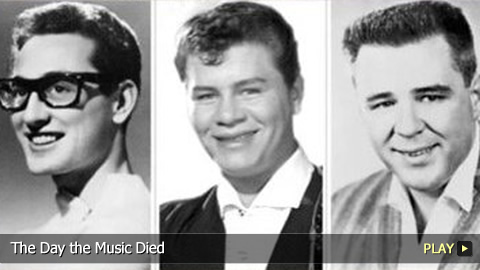The Day the Music Died: Buddy Holly, Ritchie Valens and The Big Bopper

- Buddy Holly's Early Life
- Buddy Holly and The Crickets: Success
- Ritchie Valens' Early Life
- Ritchie Valens: Musical Success
- Jiles Perry Richardson's Early Life
- The Big Bopper: Making History as a DJ and Recording Artist
- Next Stop on the Winter Party Dance Tour
- Passengers on the Plane
- Take-Off and Crash
- Causes
- Musical Legacy of the Rock and Roll Pioneers
Buddy Holly’s Early Life
Buddy Holly, whose real name was Charles Hardin Holley, was born September 7th, 1936 in Lubbock, Texas. He learned various instruments from his older brothers and began performing at talent shows and clubs in high school. Soon, Holly incorporated rockabilly and rock into his bluegrass musical style after being influenced by Elvis Presley and Bill Haley & His Comets.
Buddy Holly and The Crickets: Success
After a few unsuccessful Decca Records singles, Holly and his band The Crickets had their first smash with 1957’s “That’ll Be the Day.” During his lifetime, he released three studio albums as a solo artist and with his band: The “Chirping” Crickets, his eponymous sophomore effort and That’ll Be the Day. Despite the band’s eventual breakup, Holly continued recording profusely, and because of this new material was released for years after his untimely passing.
Ritchie Valens’ Early Life
Ritchie Valens was born Richard Steven Valenzuela on May 13th, 1941, in Pacoima, California. He was exposed to Mexican and Spanish music early, and after learning to play multiple instruments he played at numerous events by his mid-teens.
Ritchie Valens: Musical Success
Shortly after signing to Del-Fi Records in 1958, Valens began recording with a full band at Hollywood’s Gold Star Studios. Though no full-length albums were released during his lifetime, Valens did record several successful tracks: these included the number-two hit “Donna” and a rock and roll rendition of the Mexican folk song “La Bamba.” Valens soon dropped out of high school to play shows across the country, make numerous television appearances and to continue recording. The songs from this period later emerged on posthumously-released albums.
Jiles Perry Richardson’s Early Life
Jiles Perry “J.P.” Richardson, Jr. was born October 24th, 1930 in Sabine Pass, Texas. He occasionally played with his college band, but really pursued his love of music when he quit his pre-law studies to become a full-time employee at a Beaumont, Texas radio station.
The Big Bopper: Making History as a DJ and Recording Artist
Following time in the U.S. army, Richardson was given his own show and became known as “The Big Bopper.” In 1957, the DJ made history after broadcasting for over one hundred and twenty hours. He soon began writing songs and even penned number-one hits for George Jones and Johnny Preston. As a recording artist, The Big Bopper’s biggest song was the top ten pop hit “Chantilly Lace.”
Next Stop on the Winter Party Dance Tour
The fates of these three musicians connected the night of February 3rd, 1959. They were headed to Moorhead, Minnesota as part of the three-week-long, 24-city “Winter Dance Party Tour.” However, the distance between stops became a problem when the heating system of their tour bus broke due to extremely cold temperatures. As a result, 21-year-old Roger Peterson was hired to fly some of the musicians to their next destination in a small Beechcraft Bonanza 35 plane.
Passengers on the Plane
In an ironic twist, many of those aboard the plane were not meant to be: as The Big Bopper had a cold, Holly’s bass player Waylon Jennings gave him his spot. Valens won his seat in a coin toss with Holly’s guitar player, Tommy Allsup.
Take-Off and Crash
Despite light snow, the single-engine aircraft took off at close to 1:00 a.m. local time, but quickly disappeared from sight. Due to the weather and an inability to establish radio contact, the crash site was only discovered the next morning when plane owner Hubert Dwyer found the debris miles from Mason City Municipal Airport, near Clear Lake, Iowa.
Causes
Poor visibility and pilot error were named as likely causes of the accident. The coroner reported the impact of the crash had caused brain trauma and resulted in the unfortunate deaths of all those aboard.
Musical Legacy of the Rock and Roll Pioneers
Even after their premature deaths, the legacies of these musicians lived on. The Big Bopper was remembered as a record-breaking deejay; Ritchie Valens opened doors for Chicano and Latin rock; and Buddy Holly popularized the band line-up of two guitars, bass and drums while appealing to both black and white audiences with his mix of rockabilly, country and R&B. As such, they will forever be remembered as architects of rock and roll with an influence that reaches far and wide.
